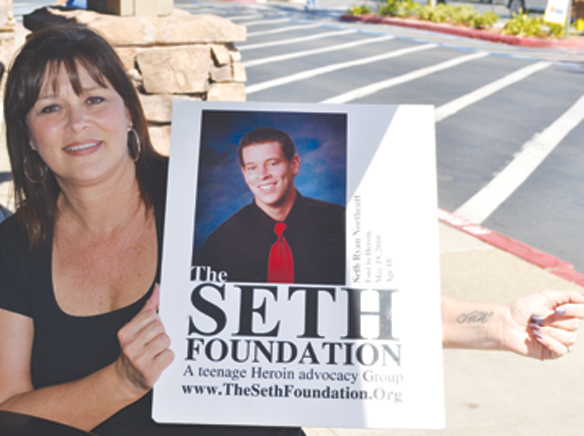Published statistics on substance abuse and it’s related crimes reveal an undeniable public health and safety problem. Put them on a face, a name, a person in the community and the story changes. It touches most people to some degree, and the odds game played in the minds of parents and family members becomes true heartache.
Published statistics on substance abuse and it’s related crimes reveal an undeniable public health and safety problem. Put them on a face, a name, a person in the community and the story changes. It touches most people to some degree, and the odds game played in the minds of parents and family members becomes true heartache.
“There is nothing easy about dealing with kids on drugs,” said Karin Murphy, president of The Seth Foundation, a teenage heroin advocacy group founded in 2010. A PTA mom, her son Seth Northcutt played little league, played with nice kids from families his parents knew. At Granite Hills High School, Seth befriended other kids, tried drugs, and began a struggle that his mom was admittedly unequipped to recognize.
“I never did any drugs,” she said. “I didn’t know what to look for.”
Many parents are blind sided by children’s drug use, and systems set in place to help often do not provide the answers or assistance needed.
“Seth’s doctor told him, ‘Stop using,’” she said. “We had insurance but ran into issues getting him into rehab. The schools don’t want to acknowledge the problem. I had no idea what to do with him.”
Like other young substance abusers, Seth did not start with heroin but became almost instantly addicted once he tried it. After that, funding his habit went to extremes.
“Kids and addicts are master manipulators,” added Mike Murphy, Seth’s father who recounted the tough love tactics used to try to control Seth’s attempts to get heroin, which included taking away his cell phone and car. In December 2009, Seth was arrested for heroin possession as a minor. In April 2010, at the mercy of his addiction he was arrested for being the driver in a burglary. That time, he was an adult.
In May 2010, Seth was given three years probation. Part of probation was a work program, which on Monday, May 17, Seth never made it on the bus. He got high, again.
“I picked him up, and the plan was for him to go to an AA meeting that night,” Karin Murphy said.
She has told this story to any school, church group, or newscaster who would let her. Seth Ryan Northcutt became hypoxic due to drug poisoning and died on May 19, 2010.
Within six weeks of his passing, The Seth Foundation was born. In grief, the Murphy’s strive to help kids, parents, and families affected by drugs. Seth also helped people after his death. His kidneys, lungs and heart were donated.
To prevent everything from the first high to fatal overdose, The Seth Foundation does many things to fight the epidemic of substance abuse.
“I hold meetings in my house, I take calls from parents around the clock, I’ve spoken to politicians about changing laws,” Karin Murphy said.
The more people know, the more they can do to avert, or handle, drug abuse, and that is her plan now.
“I wish I’d been more proactive, gone through his things,” she said.
She works with and refers FireNarc (www.firenarc.com), certified K9 and investigator teams that perform searches of homes and schools for drugs. The Murphy’s support prescription drug monitoring programs, catalog abusers and overprescribing doctors. They contacted Sen. Joel Anderson about legislation allowing financially liable parents access the medical records of their adult dependents who ER- and doctor-shop for drugs.
“Many parents are in denial about their kids and drugs,” she said, explaining that cell phones are one of the most useful tools for getting drugs. Kids seeking drugs simply access the web to find where to get and how to make drugs, how to arrange drop spots, get high with ease, and without detection.
The Seth Foundation makes every attempt to inform parents, offer advice to everyone who reaches out to them, and give back to others fighting for the same cause. Ten percent of all the foundation’s proceeds are donated to a local rehab with a high success rate.
Rehabilitation efforts can be a life changing option, but are not always a guarantee. Until substance abuse affects the average citizen personally, they do not know what they do not know. By then, it is often too late, and swift action is required to help.
There are many culprits of substance abuse—but heroin has become an increasingly popular, inexpensive and an accessible high. In many cases, substance abuse starts in the home. Prescription drugs are addictive and readily available in medicine cabinets of parents or grandparents.
According to a SANDAG report, 63 percent of arrestees for drug use said they switched to heroin instead of pills because it was cheaper and easier to get. Between 2007 and 2012, seizures of heroin at San Diego points of entry rose from 111 to 470.
A thumbnail size rock of black tar heroin from across the border costs about $10. It is carried via condoms in body cavities of users and sellers, young and older.














